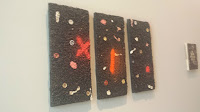William Ivins explains how design is based on craftsmanship
and the two are different established by the study of the two. The difference between
design and craftsmanship is that design involves creating a technical language,
ornamental drawing or blueprint on drawing paper for the craftsman. In
comparison, the craftsman works from that sketch on the drawing paper. The
author says it is important to collect and study drawings, prints and book
decorations because not only for proper understanding of the functional growth
and development of ornament but also as the source for inspiration of a new
design.
The museum communicates this idea of collection and
study because the museums display valuable collections of woodwork, plates,
pottery, furniture and textiles. In addition, museums display these collections
to and study of drawings, book decorations, and prints to influence and inspire
viewers to create new designs for creating potential artwork. Irvins, explains
how this country has been tending to fail in design and is falling behind the
development of craftsmanship. He
clarifies, it is important to collect and study drawings, prints and book
decorations because not only for proper understanding of the functional growth
and development of ornament but also as the source for inspiration of a new
designs.
Furthermore, Irvins expresses how museums should be more progressive as a collective force towards establishing great collections of ornament and utilizing it so that artists may turn to for inspiration and aid when they have learned the art.

























































